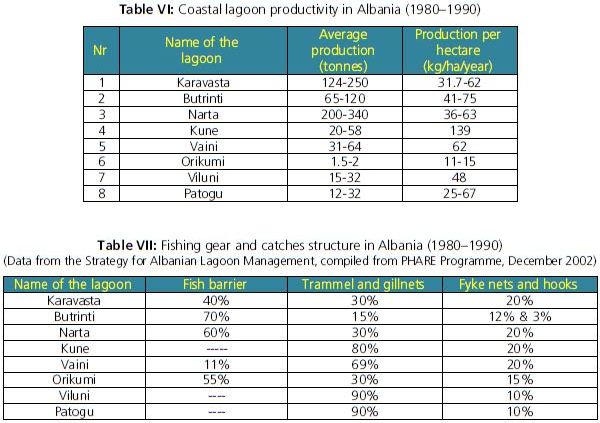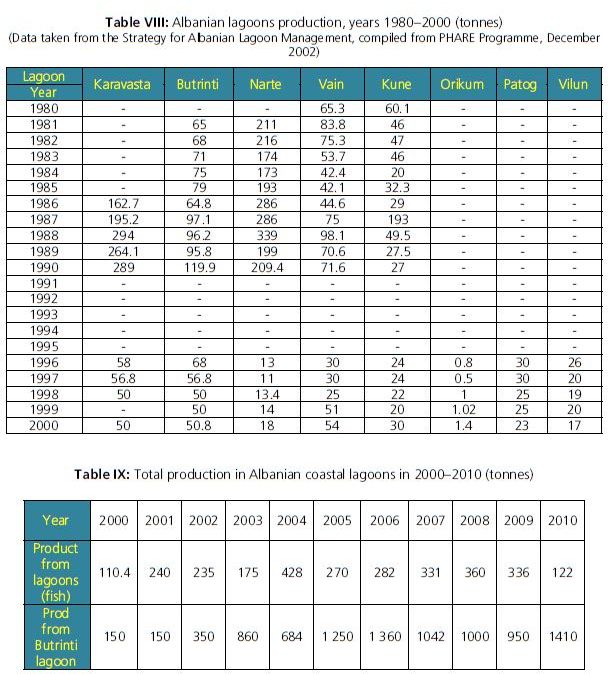1.5 Lagoon exploitation
Since Illyricum times, lagoon fisheries have been very important in coastal zones providing local populations with an important source of food. Remnants of fishing activities in Illyric tribes dwellings (fish bones, fishing tools, bone and bronze hooks, iron and bone harpoons, boats, etc.) witness the existence of ancient fisheries cultures.
1.5.1. Aquaculture and capture fisheries facilities
Fishing boats
Nowadays, different kinds of fishing boats are used according to the physical features of lagoons (water depth, water flow, etc.). For example, in the Shkodra lagoon the so-called “take” and “patogu” boats are used: the first is a thin and long shaped boat while the second is relatively short and wide. These fishing boats can be with or without engine, depending on the distance to the fishing grounds.
Fishing gear
The main fishing gear used in Albanian lagoons includes fish barriers (“dajlan”) installed in front of the water current. This is a generally artisanal gear similar to the gear historically used in Mediterranean lagoons composed of natural and/or plastic cans combined with wooden poles. Their contruction and use are regulated by law, according to fishing periods, and the areas close to fishing barriers are forbidden to external users.
Gillnets, entangling (trammel) nets and hooks are commonly used in Albanian lagoon areas. Harpoons were used during the 1990s but are now forbidden.
Fyke nets are also a very common fishing gear for eel fisheries in all Albanian lagoons. These can be made of one or or more traps and are called “gogola”.
In the Vaini and Patogu lagoons, fishers also catch along the coast using fix articulated fishing traps acting as an obstacle net system in which the fish is captured into several conic-shaped or pyramid-shaped rooms. This fishing method is a heritage from previous cooperation between Albania and the USSR during the 1960s.
Employment
In Albanian lagoons fishing activities are carried out by fishers or fishers groups that are organized either in licensed companies or fishers groups (when fishweirs are used) or through a system of individual licenses.
At present, the only area where a producers’ organization exist is the Narta lagoon (fishery management organization – FMO).
The number of fishers is as follows (census made by the author):
Viluni lagoon: 10 fishers
Kune lagoon: 15 fishers
Vaini lagoon: 30 fishers
Karavasta lagoon: 53 fishers
Orikumi lagoon: 6 fishers
Narta lagoon: 40 fishers
Patogu: 20 fishers
Butrinti lagoon (fish and production): 280 fishers

Figure 2. Employment (fishers) in Albanian lagoons
1.5.2. Aquaculture and capture fisheries management
In Albanian coastal lagoons, aquaculture is limited to extensive activities. In the Butrinti lagoon, mussels culture is carried using concrete poles and float lines.
In some lagoons such as Kune, Narta, Butrinti and Patogu, fishers have delimited through nets or pens fishing areas dedicated to fattening and wintering fish juveniles captured at the fishweirs. Fishweirs are present in many lagoons and their functioning is managed and regulated by the law.
Fishing in the communication channels and within a radius of 2 km from the outfall channel to the sea is prohibited.
According to the regulations in force, fishweirs must be open (no fishing function) as follows:
Shkodra 15 March to 31August
Viluni 15 March to 30 September
Merxhanit 10 March to 31July
Ceka 10 March to 31 July
Patog 15 March to 30September
Karavasta 5 March to 5 May
Narta 10 February to 10 April
Orikum 15 March to 15 June
Butrinti 1 April to 30 June
Prita e Rrezes 15 April to June 15
During these periods, fishing is forbidden except for hooks.
Moreover, it is forbidden in particular to:
• place fishing canes (or plastic, metallic tubes, etc.) in the fishweir at a distance less than 12 m;
• fish with trawl nets and dredge;
• place fixed equipment closing the river stream to the sea to the lagoons; • use gillnets and entangling/trammel nets with a mesh size less than 48 mm in coastal areas and 60 mm in coastal lagoons.
1.5.3. Production
Production in costal lagoons between 1980 and 2010 is reported in the tables below, based on data from the Albanian Fishery Directorate and Fishery Research Institute.
Table VI: Coastal lagoon productivity in Albania (1980–1990)
Table VII: Fishing gear and catches structure in Albania (1980–1990)
(Data from the Strategy for Albanian Lagoon Management, compiled from PHARE Programme, December 2002)

Table VIII: Albanian lagoons production, years 1980–2000 (tonnes)
(Data taken from the Strategy for Albanian Lagoon Management, compiled from PHARE Programme, December 2002)
Table IX: Total production in Albanian coastal lagoons in 2000–2010 (tonnes)
